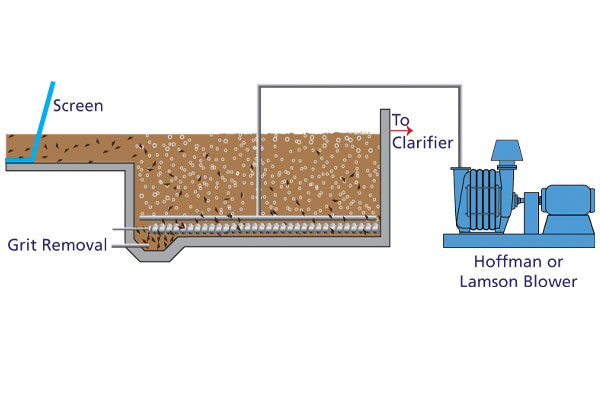Choose a different country or region to see the content specific to your location
Select Your Country/Region
Current Region:
 Global (EN)
Global (EN)
Choose a different country or region to see the content specific to your location
Current Region:
 Global (EN)
Global (EN)
How can we help you?
HOFFMAN & LAMSON blowers are custom made and designed to provide specific airflow and pressure. The air our blowers provide for aerated grit chambers is very efficient. Our blowers are the most well-known brand in the wastewater treatment industry and uphold its reputation for longevity and service.
An aerated grit removal system removes particles by forcing water that has passed through bar screens into a grit chamber, which has air pumped into it. The air causes a spiral of water to flow through the tank and heavier particles are thrown out of the water's streamline. Eventually, after hitting the wall, the heavier particles settle to the bottom of the tank, while the lighter organic particles are suspended and eventually passed through the tank.
Wastewater usually contains a relatively large amount of inorganic solids called grit (e.g. sand, cinders, and gravel). This material will damage pumps by abrasion and cause serious difficulties in sedimentation tanks and sludge digesters. Thus, it is common practice to remove this material in grit chambers.
After larger solids are screened out of the effluent, raw sewage rapidly flows into the grit chamber. The purpose is to settle out inorganic material, but not to allow organic material to settle. Removing grit is important to protect downstream pumps, centrifuges, and heat exchangers and to reduce deposits from forming in the pipelines and channels.
An aerated grit removal system removes particles by forcing water that has passed through bar screens into a grit chamber, which has air pumped into it. The air causes a spiral of water to flow through the tank and heavier particles are thrown out of the water's streamline. Eventually, after hitting the wall, the heavier particles settle to the bottom of the tank, while the lighter organic particles are suspended and eventually passed through the tank.
Having the right amount of air is important because excessive quantities of air can cause the roll velocity to be too high, which results in poor grit removal. Insufficient quantities of air result in low roll velocities, and excessive organic matter will settle with the grit.
The grit chamber and microorganism processes are often combined in one process. When this happens, the grit basin is dedicated to removing solids, and activated sludge is added to a separate aeration operation.

There are three types of aerated grit chambers:
• Horizontal flow chambers are the oldest design, and they work by controlling the flow vortices to settle as much particulate as possible.
• Vortex chambers have a rotating turbine with variable pitch blades that can control the size of grit allowed to settle.
• Aerated use flow vortices and aeration to remove inorganic materials and are popular because they greatly reduce the excessive wear on grit chamber handling equipment and frequently eliminate the need for separate grit washing equipment.

Equipment is tested before reaching the customer or end-user. Thus ensuring top quality and avoids unforeseeable issues or operational downtime. Therefore, upholding Hoffman & Lamson’s strong reputation as the global leader of engineered vacuum solutions and producing premier quality products efficiently and economically. There are over 100,000 HOFFMAN & LAMSON multistage centrifugal blowers and exhausters in operation worldwide.
ABOUT Hoffman™ and Lamson™
Hoffman™ and Lamson™ brands of centrifugal blowers and exhausters are among the many compressed air and gas technologies manufactured by Gardner Denver Inc.
Part of the Nash Division, they are American originals. Hoffman™ and Lamson™ brands have been setting industry standards for excellence, reliability, and customer satisfaction for over 100 years. Lamson, established in 1880, and Hoffman, in 1905, are brands customers know and continue to trust.